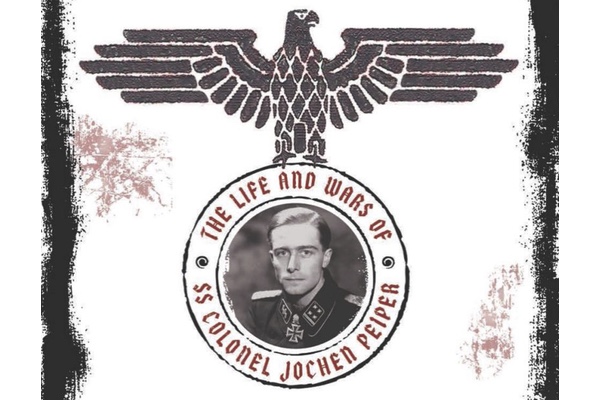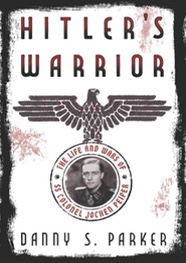My 20 Year Search for the Truth About One of Hitler's Most Infamous Soldiers: Col. Jochen Peiper

For the last twenty years, I have labored to craft the story of Joachim Peiper, a seemingly minor character during World War II and also within the Third Reich.
Peiper had been the youngest SS colonel in the war, a dashing tank commander in Hitler’s Germany. His notoriety was sealed as his command was involved in the infamous ‘Malmedy massacre’ when 84 American soldiers were executed after surrendering on December 17, 1944. Later, Peiper was tried at Dachau, found guilty, and sentenced to death. However, he was released after a controversial Senate investigation that vaulted Sen. Joseph McCarthy to national notoriety. Peiper subsequently worked near Stuttgart in the automotive industry. Later, becoming disenchanted with his native land, he retired to Traves, France where he was murdered in 1976.
 What prompted me to write the story
about this dark personality?
What prompted me to write the story
about this dark personality?
The answer stretches back to the 1980s when I became fascinated by the history of the Battle of the Bulge. How had the seemingly unstoppable American march towards victory been thrown into such chaos in the Ardennes? I endeavored to find the answers at the U.S. archives by researching the conflict from both sides. Later, archivists put me into contact with Charles B. MacDonald, Deputy of Military History in Washington D.C. who was working on a new book on the Bulge, A Time for Trumpets. Later we lead tours for American veterans through the Ardennes and it was during a conversation in Clervaux, Luxembourg in 1986 that the real genesis of ‘Hitler’s Warrior’ was born. Sitting in the Hotel du Commerce, MacDonald nursed a scotch as he we discussed our coming tour of the line of advance of ‘Battle Group Peiper’. I was already familiar with Peiper. “You know he was the adjutant of Himmler,” MacDonald began. “I think if you could understand that man, you might be able to understand the entire war from Hitler’s side.” MacDonald further ventured that Peiper’s life and mysterious death was ripe for a book.
Intrigued by the suggestion, I began researching Peiper’s life, figuring it could be completed in a few years. This proved woefully inaccurate. The 37,000 pages on ‘Malmedy’ alone in the archives took years to examine. Additionally, work at the Bundesarchiv locations in Germany encompassed further time. Prospective interviewees were tracked down. That first year I ventured to Untergruppenbach to interview Ralf Tiemann, the last historian of Peiper’s division, the ‘Leibstandarte Adolf Hitler.’ Tiemann was surprisingly helpful and forthcoming; he recalled a poignant story about Peiper following the failed advance in the Ardennes. “They arrived with icicles hanging from their uniforms,” he remembered. Peiper, normally well groomed, looked haggard as he eyed Tiemann. “We left Germany with 3,000 men,” waving his hand in disgust, “and now we have 717, you can find the others the whole way back along our path.”
Although with hesitation, Tiemann put me in touch with other veterans. I was one of the few Americans admitted to the Treffen—meetings—of the old comrades of the 1st SS Panzer division. Many who knew Peiper personally were willing to talk openly. Depressingly, their attitudes postwar had hardly changed; one ventured “Those were the good old days … we came close to winning. It was only the Americans and the material they had that stopped us. We would have created a better Europe.” Another tank officer who knew Peiper told me my question regarding prisoners on the Eastern Front was naive. “It is one matter to shoot prisoners,” he railed. “ It is another matter not to take them.”
But there were research breakthroughs that couldn’t be anticipated. I located some unusual records associated with Himmler – photo albums in particular –at the Hoover Institution at Stanford University in California. As Peiper was with Himmler from 1938-1941, it was worth a visit to see if he had featured in those dusty records. Alas, the photos revealed nothing. I was mentally preparing to leave when the kindly archivist, Linda Wheeler, informed me of a box of “uncertain provenance” in the collection.
The material was not thick when I opened the box at 4:20 PM that day. The front content was familiar, but then several pages galvanized my attention. It was a folder with a sheaf of letters in Jochen Peiper’s own handwriting which were addressed to Hedwig Potthast, Himmler’s mistress. These dated from 1941 to 1944 and all were written from the war front. Two others belonged to his wife, Sigurd Peiper, a former secretary to Himmler. I left that rainy evening elated, having found a treasure trove no one had previously recognized! Transcribing these letters was revealing. Letters to Hedwig (fondly referred to as Häschen or “Little Bunny”), provided remarkable insight into his perspective on Himmler and the war. The intimacy of the language was intriguing - at last I had insight into the inner thoughts of my subject.
23 September 1941
My Dear Häschen,
I always hoped you would send sometime short greetings into our desolate Steppe. Unfortunately, you seem to have forgotten me totally. I feel very differently you see. Desire and loyalty are welling up inside me and multiplied greatly by the distance. I am happy to be permitted participation in this war that is so necessary for our people and for you to be safe at home.
I feel strongly again how good it feels, to venture out to the front one more time-- this should be the last big campaign in which our unit is participating. But I’m not just “a war junky” looking for and desiring the war.
The long activity under the conditions well known to you has built up an immense pressure, which now demands a valve and some distance in time. But already today, I notice that one cannot get away from the stable in which one snorted through one’s nostrils and pointed one’s ears for three years. Should I bring my skin home undamaged - this, by the way, is not that simple - I shall be available again unconditionally.
For today and as always, I wish you the best. Please greet the ‘Somebody’ heartily from me
‘Somebody’ was clearly Himmler.
What of the Malmedy crossroads that had sealed Peiper’s postwar reputation? In 1995, I was introduced to Ted Paluch a Malmedy survivor. “I am sure they thought they were doing their job,” he stated without malice of his attackers. An early meeting with author John Toland proved fortuitous; he knew Peiper personally. “He was a strange man,” Toland ventured, “I think he sought his end there in France… I warned him.” Peiper had dismissed his warning. Toland later claimed a French official told him who was responsible for Peiper’s death but refused to reveal his source. Still, he encouraged as many interviews as I could manage; I spoke with nearly 200 people including Peiper’s son, villagers in the tiny French village where Peiper met his end and a host of others. What would I learn?
One of the most telling subjects was Fritz Kosmehl; a crew member of Peiper’s personal tank who was blinded by an American tank shell in August 1944. Postwar, he remained in communication with Peiper, then incarcerated in Landsberg prison. Peiper admired his fortitude and after the war they met several times, sharing a passion for reading and intellectual discussion. He and I engaged in a long correspondence and he seemed to know much of Peiper’s postwar sympathies, but he told me much of this was personal and he was only willing to relate it in person. We arranged to meet at his home in Oldenburg in December 2004. There, Kosmehl recalled his earlier days, although focused on composing his memoires which he generously shared.
Had Peiper finally had a change of heart at the end of his life, I asked. Kosmehl leaned forward. “Peiper really wanted to change,” he whispered, “but he could not …The weight of the past was too much.”
Hitler’s Warrior showcases an SS officer’s unique vantage on the Second World War—the dark side from Everyman. Through Peiper’s eyes, we come upon a vision from a different era and one rife with the forbidding ethical terrain that was Hitler’s regime. In some ways the war goes on; today Peiper remains a cult-hero to neo-Nazis.
Even as the last veteran witnesses from the war disappear, we do well to recall the words of William Faulkner. “The past is never dead,” he concluded, “it’s not even past.”
